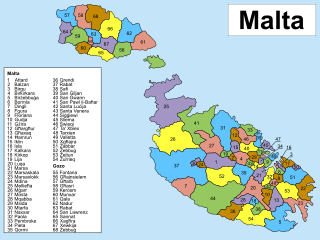
The politics of Malta takes place within a framework of a parliamentary representative democratic republic, whereby the President of Malta is the constitutional head of state. Executive Authority is vested in the President of Malta with the general direction and control of the Government of Malta remaining with the Prime Minister of Malta who is the head of government and the cabinet. Legislative power is vested in the Parliament of Malta which consists of the President of Malta and the unicameral House of Representatives of Malta with the Speaker presiding officer of the legislative body. Judicial power remains with the Chief Justice and the Judiciary of Malta. Since Independence, the party electoral system has been dominated by the Christian democratic Nationalist Party and the social democratic Labour Party.

Since June 30, 1993, Malta has been subdivided into 68 localities, governed by local councils, Maltese: kunsilli lokali, meaning municipalities or borough. These form the most basic form of local government and there are no intermediate levels between it and the national level. The levels of the 6 districts and of the 3 regions serve statistical purposes.

Local elections were held in Malta on 12 March 2005. The Malta Labour Party won an absolute majority. Approximately 68% of the eligible voters turned up on election day. In Malta the vast majority of the electorate normally votes on election days, with turnout sometimes averaging above 92% for general elections.

Democratic Alternative, sometimes referred to as AD – The Green Party, is a green political party in Malta particularly dedicated to environmentalism.
Malta is the country with the most holidays in the European Union. Since 2005, any holidays falling on Saturdays or Sundays do not add an extra day to the workers' leave pool.

Malta is subdivided in districts of localities in order to administer the country in regions rather than locality. The districts have no administrative significance as the local councils provide the first-tier divisions of the country.
This page list topics related to Malta.

The coastline of Malta consists of bays, sandy beaches, creeks, harbours, small villages, cities, cliffs, valleys, and other interesting sites. Here, there is a list of these different natural features that are found around the coast of Malta.

In the small Mediterranean island nation of Malta the predominant religion is Roman Catholicism.

General elections were held in Malta on Saturday, 8 March 2008 alongside local elections. The governing Nationalist Party won a narrow victory over the Malta Labour Party.

Local elections were held in Malta on 8 March 2008, the same day of the general election. This year, the election was held in 23 of the 68 Maltese localities. These 23 localities are: Valletta, Senglea, Żebbuġ, Żejtun, Balzan, Dingli, Fontana, Għajnsielem, Għasri, Iklin, Kirkop, Marsa, Mellieħa, Mqabba, Nadur, Pembroke, Qrendi, San Ġiljan, San Pawl il-Baħar, Santa Venera, Ta' Xbiex, Xewkija and Żurrieq. A separate local election was held on 24 May in Mtarfa, after the previous council was dissolved a monthly earlier. 12 candidates contested the election, in which 3 councillors were elected for the Nationalist Party while 2 councillors were elected for the Malta Labour Party (MLP).
Post codes in Malta are seven-character strings that form part of a postal address in Malta. Post codes were first introduced in 1991 by the mail operator MaltaPost. Like those in the United Kingdom and Canada, they are alphanumeric.
The 2011 council elections in Guildford saw the Conservatives retain control over Guildford Borough Council with an increased majority of 20 seats. Full results for each ward can be found at Guildford Council election, full results, 2011.

In Malta most the main roads are in the outskirts of the localities to connect one urban area with another urban area. The most important roads are those that connect the south of the island with the northern part, like Tal-Barrani Road, Aldo Moro Street in Marsa and Birkirkara Bypass.

Gozo Region is one of five regions of Malta. The region includes the islands of Gozo, Comino and several little islets such as Cominotto. The region does not border with any other regions, but it is close to the Northern Region.

Fleur-de-Lys is a suburb that forms part of Birkirkara, and it is also considered a suburb of Santa Venera and Qormi. It lies approximately 5 kilometers away from Malta's capital, Valletta. The population of Fleur-de-Lys is about 2000 people and the area is very small.

The Central Region is one of five regions of Malta. The region includes the central part of the main island of Malta. The region borders the Northern, Southern and South Eastern Regions.



















